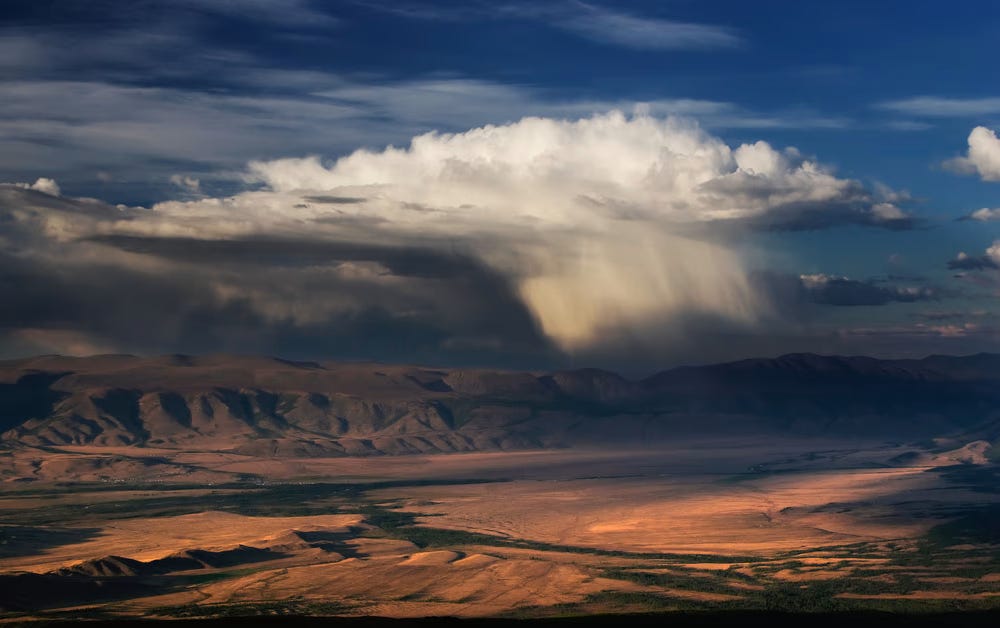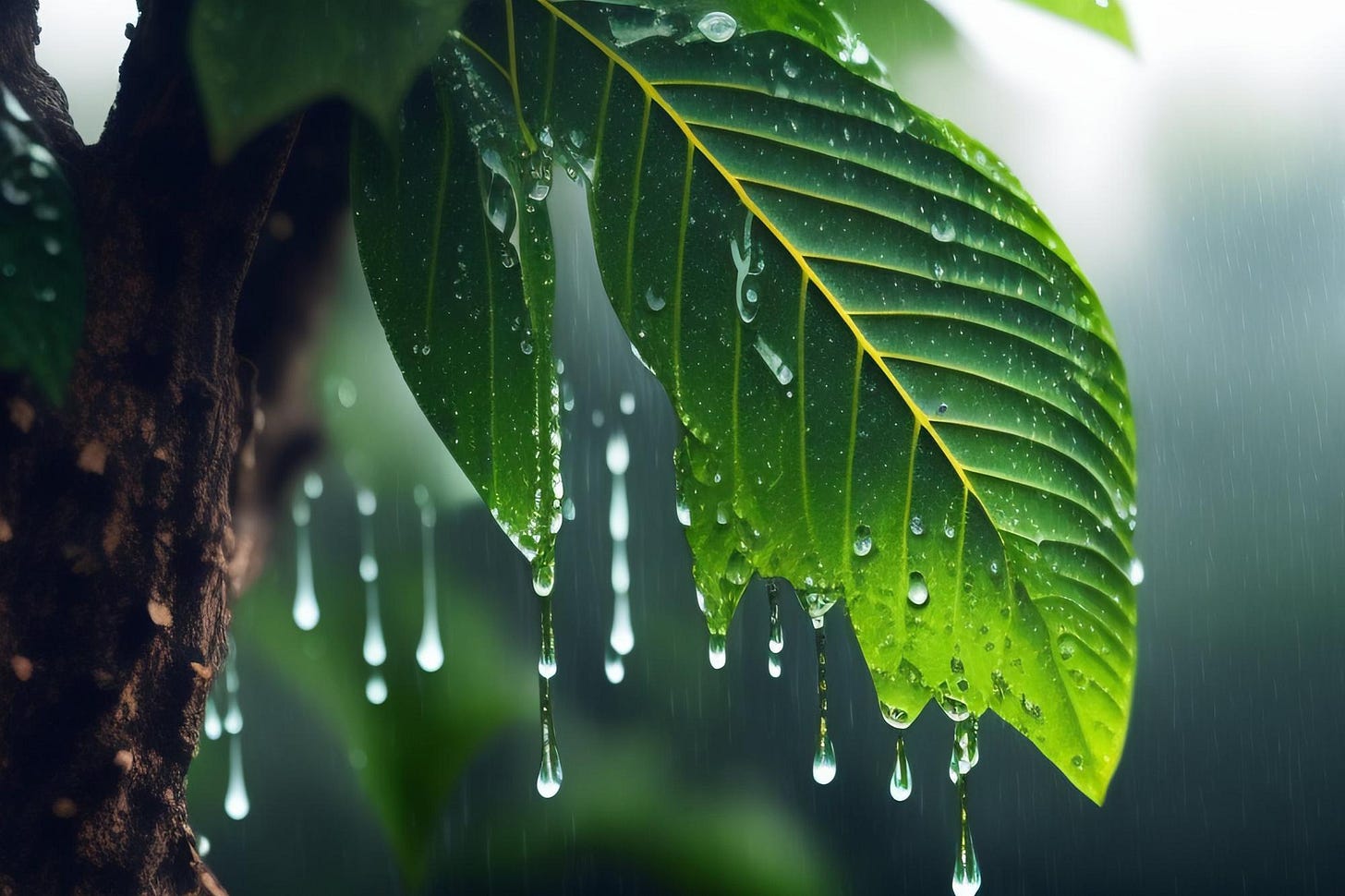Reimagining Rain
8/17/23 – Some reflection after a long, wet summer
Hello everyone:
For those of you wanting some Anthropocene context for the fire and carnage in Lahaina on Maui, I recommend the recent piece by Emily Atkin at Heated. Links below in the curated news.
Likewise, below you can read about the landmark victory of the 16 young plaintiffs in the groundbreaking Montana lawsuit against the state for violating their constitutional rights to a healthy environment.
I hope some of you had the time and opportunity to watch the Perseid meteor showers last weekend. Heather and I experienced more mosquitos than meteors, but we laid out on the porch for a while and caught several, including a bright fireball.
As always, please remember to scroll past the end of the essay to read some curated Anthropocene news.
Now on to this week’s writing:
Like any playful child, I’ve had rain on the tip of my tongue this summer. There’s been a lot of rain to talk about. Here in midcoast Maine, like the rest of New England, it’s been a very wet few months. Today has offered a steady drizzle. Unlike much of New England and upstate New York, though, the rain has not crashed through our lives and living rooms in wild torrents. We haven’t flooded, but we’ve been soggy, thunderstruck, damp, humid, mosquito-haunted, and thoroughly clammy since early June. There’s scarcely been a day when a piece of paper lying out on a table or kitchen counter hasn’t lost the will to live.
I could moan a bit about the vegetable garden – the moist enthusiasm of slugs and snails, the loss of seedlings, the pale apathy of tomato and basil plants – but I’m not complaining. A quick survey of the rest of the U.S. tells me that a soggy squash patch is better than extreme heat in the south and southwest, drought in the west, fires throughout the Canadian north, and smoke blowing down the rest of the east coast. Elsewhere in the world, 25 countries populated with a quarter of humanity are suffering extreme water stress, while severe floods ravaged parts of China, Korea, and India.
No place is climate-safe on a planet that has converted two-thirds of its grasslands and a third of its forests for farming and grazing, and that has burned tens of millions of years of stored fossil energy in mere decades, but Maine in this moment is doing okay. Who knows what next year might bring?
But again, it’s rain that’s on my mind. Not in the way it addled the minds of the humans on Venus in Ray Bradbury’s short story “The Long Rain,” though. The rhythm of rain on my head isn’t driving me insane. No, the sound of rain is always welcome and beautiful, from the patter of the first fat drops in the dust of a hot July day to the roar of a downpour sweeping through forest leaves like the sea.
Rain asks for rumination, so I’m ruminating.
That Bradbury story starts with this paragraph, one that folks in flood-ravaged Vermont can probably relate to:
The rain continued. It was a hard rain, a perpetual rain, a sweating and steaming rain; it was a mizzle, a downpour, a fountain, a whipping at the eyes, an undertow at the ankles; it was a rain to drown all rains and the memory of rains. It came by the pound and the ton, it hacked at the jungle and cut the trees like scissors and shaved the grass and tunneled the soil and molted the bushes. It shrank men’s hands into the hands of wrinkled apes; it rained a solid glassy rain, and it never stopped.
I’m going to venture outward into the rain here, which also means venturing upward and downward, and occasionally inward. I’ll circle back to those “hands of wrinkled apes.” My goal this week has been to learn more about rain, to enrich the stories we tell about it, and to articulate it to you in a way that might help you reimagine your relationship with this damp revelator.
Rain, after all, is where we literally understand – to stand under is to receive what falls to us – and connect to a taste of what is wild and real and home.
Some of these notions you know already, I’m sure, but hopefully you’ll find something to think about.
***
Rain doesn’t live in the sky: It lives in the ocean and lakes and sends a little of itself to rise with the wind to greet the Sun. It lives in the soil and commutes to the atmosphere through plants. Water begets water, soil is the womb, and vegetation is the midwife, as Millan Millan and Rob Lewis reminded us. The formation of rain on high, and its descent, are only part of a journey that begins at our feet. Or really, it neither begins nor ends. Rain breathes.
Mostly it sleeps: in lakes and mountain glaciers for decades, in shallow groundwater for a couple centuries, in the ocean for millennia, in deep groundwater for 10,000 years, and in Antarctic ice for tens or hundreds of thousands of years. Its time in the atmosphere, in contrast, is a lark that lasts only nine days.
Rain has a heart: Water vapor won’t condense into a droplet unless it has something to condense on: a nucleus. Without nuclei, there would be no clouds. These nuclei have lifted off the ground like the vapor pulled upward by the Sun, and once they meet, and the cloud droplet swells from its initial .02 mm to raindrop size (2.0 mm), they fall together. It is tempting to say every raindrop has a heart, but rain drops burst against each other in the chaos of falling and so some of what arrives on your window, lawn, or tongue may not have a crunchy core.
What works as nuclei? Bacteria and other microbes by the trillions, desert dust and clay particles by the ton, vast quantities of sea salts, sulfates from volcanic eruptions, mushroom spores, conifer pollen, soot from wildfires, and dimethylsulfide produced by healthy coral reefs, to name some of the usual suspects.
And then, recently, we added some other contenders: burnt fuel particulates from aircraft, ships, and industry, antibiotic-laced dust from cattle feedlots, and many more, including perhaps PFAS chemicals, some of which are already known to work as ice nuclei in higher clouds.
PFAS chemistry is a horror we’ve added to the sky, and as the rain cleans the air it brings the horrors home to roost. It is a brutal Anthropocene fact that rain and snow around the globe, even in the most remote areas, carry these “forever” chemicals at levels that make it unsafe to drink.
And the irony – or the echo, really – of that horror is that the heart of the waterproof raincoats we wear in the rain are usually infused with the same chemicals.

Rain as jellyfish: It has been some years now, but I have a great fondness for sprawling on mountaintops and watching a scattering of flat-bottomed summer clouds dangling rain as they sail at eye level across the forests and waters of this beautiful world. The illusion of being underwater watching vast jellyfish is just one more joy in the abundance of joys inherent in resting at altitude.
Sometimes the tentacles don’t reach the ground. Virga (from the Latin for “branch” or “streak”) is the term for the rain that dangles but doesn’t make it home. The raindrops are unmade as they’re eaten by dry air. “Torture by tantalizing, hope without fulfillment,” wrote Ed Abbey in Desert Solitaire.
Once, as I walked unmarked hunters’ trails in Luberon Regional Natural Park in Provence, on a very hot dry day, a few fat drops hit the dust around me. And that was it.
But those few drops reminded me suddenly of perhaps the most elegant fossil I’ve ever seen. In the natural history museum at Amherst College is a desk-sized slab of Jurassic mud recording a two-hundred-million-year-old moment of rain much like mine in the Luberon. A few fat drops fell and were then captured, like a photograph in stone.
Or rather, the impressions were captured. Those raindrops are still around, somewhere.

Rain is ancient, yes. But it is equally new. Maybe you’ve heard that the molecules of water dripping off your nose may have once slid down the spine of a triceratops. Water molecules, like matter, are neither created nor destroyed. They share an existence of constant transformation.
Yet the pattern of rain clouds jellyfishing through the atmosphere at this moment is likely unique in world history. There’s so much flux and subtlety in clouds, a dynamism that befuddles forecasting algorithms and entrances skywatchers. There’s an analogy for this in the ever-changing texture of the surface of the ocean. Both are familiar and impossibly strange, fingerprints that form and vanish every instant. And both are analogies for the mutability of life itself, the infinite rhythm we are part of, a rhythm heard in the patter of rain on the roof.
Rain is a reminder of the unity of all things. How many other species think of raindrops as individuals? It’s a conceit that seems particularly and peculiarly human to me. There is only rain. Or, better yet, there is only water. Rain is merely water returning to the harbor.
As much as we talk about the importance of the web of relationships that underpin the natural world, we’re still mostly thinking about a relationship between things. But species, organisms, organs, traits, genes, cells are not things; they’re nodes in the relationships. Energy passes through Earth systems and networks of life, nutrients migrate along magnetic fields, births and deaths are both transient wombs.
Because you and I and the other eight billion weird primates have a consciousness built entirely on narrative, we itemize the world and dramatize the relationship between items. As I often note here, what sets us apart from other life is our capacity and willingness to reimagine the world. This isn’t necessarily bad or destructive – witness the pre-Anthropocene million years of small-scale human activity – but the stories we tell can create unity and empathy or they can generate difference and indifference. How we think of rain is as good a barometer as any for assessing what kind of stories we’re telling.
We have already reimagined rain: It’s the annoyance that plagues a species grown soft amid climate-controlled rooms. It’s the “resource” we squander and squabble over. And it’s the increasingly unpredictable force that pushes and pulls at civilization, shaking us awake, withholding its blessing with one hand while flood-punishing us with the other. Cynthia Barnett summarizes this nicely in Rain: A Cultural and Natural History:
Modern living, with its reservoirs, irrigated agriculture, and invisible water pipes that run for millions of miles underground, dulls us to our fragile dependence on rain. El Niño– named for the Christ Child in the 1600s by the South American fishermen who first observed the warming that tends to come around Christmastime – is one dramatic reminder. Human-caused climate change is proving another.
The inequality of rain in a warming world: A warmer atmosphere holds more moisture and acts with more turbulence. The new map of intensified floods and hotter, longer droughts is an Anthropocene inequality we’ll have to suffer (especially in poor and neglected communities) as we fight to keep it from getting worse.
That inequality is rooted in the inequality that drives so much of what ails the modern human experiment – the institutionalized varieties of selfishness we label colonial, corporate, capitalist, exploitive, racist, patriarchal, and nationalist – and is pushing our presence on this planet beyond the safe boundaries of its ecological and geophysical systems. It terrifies me to say this, but ecological survival in the Anthropocene is more and more a function of good governance.
Which is why addressing our destruction of the natural world and the scourge of waste emissions that heat the atmosphere requires seemingly unrelated battles like reforming corporate tax systems, fossil fuel subsidies, and energy investments at the big banks.
As we’ve made deserts we’ve unmade rain: The loss of forests has also meant the loss of moisture. To a large degree, it’s our food that’s been doing the erasing. Desert has followed the plow and cow since the dawn of what we call civilization. Biodiverse habitats are replaced by monocultures as soil bakes and washes away.
Where trees and grasslands are erased, so is water. But the good news is that where carbon is sequestered, so is water.
If we want a more stable global water cycle, it’s not enough to rein in emissions and draw down CO2 and methane; we have to revive and restore forests as well. And we each have a role we can play here, whether helping to protect intact and semi-intact ecosystems or restore degraded ones. Half of the globe has been converted to human use, which means there’s an enormous amount of land that can be restored. As Rob Lewis writes in a Resilience article,
I know for myself, once I began learning about the biological, water-based aspects of climate, my view of climate and the natural world transformed. Muir’s oft-quoted observation, “when we try to pick out anything by itself, we find it hitched to everything else in the universe” suddenly came alive. I discovered, over and over, that when I grabbed the thread called “climate” it was hitched to everything on Earth, part of something very much alive and capable of recovery. And with that my doom, not my worry and concern and grief, but that powerless sense of doom vanished. I stood on different ground, having come to know its power.
The more you help to protect and restore green landscapes, the more you become a rain maker.
Rain as bridge: From land to sky and sky to self, sure, but also self to the cyclical, self to the beautiful self-governing world. What ignores us saves us, I’ve always thought. To me, it’s not a god that cares for us that provides salvation; it’s the vast and vibrant existence into which we’re woven invisibly but inseparably. Take a long walk in the rain while breathing in all that damp glory and tell me you didn’t feel at least a little of the safe harbor that rain finds when it falls.
“The hands of wrinkled apes”: Next time you’re walking in the rain and notice your fingertips turning into prunes, know that you’re gazing back a few million years into our early primate history. Those ancestors lived in a particularly wet era in Earth history, and research suggests that our fingers and toes wrinkle not merely because they’re wet, but because the wrinkles give us a better grip on wet surfaces. The physiological response that changes the shape of our fingers is autonomic, like breathing. It’s built into our deepest selves. That’s how much we coevolved with rain.
***
I could go on for weeks. There are books to be written about rain, what it says about the world, and how we understand it. Our lives and our cycles are woven into those of rain. There are endless quotations from poems and songs, billions of anecdotes from billions of people, and a world of ecological meanings to be teased out and connected to it all. Stories and stories of rain.
Like how for some orchids, rain is sex, or how European swifts that remain aloft for years at a time bathe on the wing in the rain, how Seattle isn’t really very rainy, or how rain may have cost Al Gore the 2000 election. The metaphors are endless: rain as the blues, rain as joy, rain as purge, as loss, as collective action, as lifeblood, as blessing and gift and nourishment.
I’ll leave you, then, with thoughts of that nourishment and our obligation to maintain a world to be nourished by it. Here’s some of a recent piece by
on rain, from his :I am grateful for the soft pitter-patter of rain that breaks a dry spell. Each drop is a gift from the skies that washes away the stress of dryness. We had a drought this spring… When the rains finally come, it is such a relief for me and the plants. We are both delighted. They respond with lush new growth. I respond with gratitude and appreciation… The rain enters the soil and an ancient alchemy nourishes the plants. My spirits rise as fast as the growing tip of a tomato plant in July. Life is feeding on life in the soil, mutualism unbound, the way of the world. I want to enter into this mutual relationship, play my part, and learn to see and engage proactively.
Oh, one more thing. If you’re looking for the best rain gauge around, I’d recommend the Stratus. It’s not ornamental, but it’s tough and accurate, and it’s the official rain gauge for NOAA. I love mine. Here’s a review.
Thanks for sticking with me.
In other Anthropocene news:
From
at , “Lahaina Used to be a Wetland.” Atkin interviews Kaniela Ing, a Hawaiian activist (and national director of the Green New Deal Network), who explains the colonial history that transformed Lahaina from the wetland-rich capital of the Hawaiian kingdom to the dry shopping district squatting on Kānaka Maoli ancestral land that just went up in flames. Here’s Ing’s recent tweet on that history:Walking Front Street end-to-end is like a Disneyland ride through the colonial timeline of capitalism in Hawaii: starting from royalty, to whaling, sandalwood, sugar and pineapple, tourism, and luxury goods. The fire is a tragic symbol of this trajectory’s terminal point.
From Maya K. van Rossum at Green Amendments for the Generations, a press statement on the monumental victory in Montana of the 16 young plaintiffs against the state government, which the judge ruled has violated the state constitutional rights of the youth to “a clean and healthful environment.” The state must now “consider climate change when deciding whether to approve or renew fossil fuel projects,” as the Times explains in their Climate Forward newsletter. This victory will likely change the legal landscape in the fight against fossil fuel companies, and should motivate all of us who live in the 47 states which do not yet have a constitutional right to clean air, clean water, a healthy environment, and a stable climate. You can work to change that by supporting a Green Amendment movement in your state.
Want to protect most of life on Earth? Protect the soil. From the Guardian, a new study confirms that most of Earth’s species live beneath our feet. Put another way, soil is the most species-rich habitat on the planet, with 90% of the world’s fungi, 85% of plants, and over 50% of bacteria. (These are rough estimates, since soil habitats are so understudied.) Despite its importance for both climate and feeding humans, soil is not often talked about in discussions about protecting biodiversity.
Check out the vital but invisible work being done by the Tax Justice Network, working across the globe to help nations (individually and together) develop tax policies that rein in corporate tax avoidance policies that deprive governments of the funds they need to fund social safety nets and environmental resilience.
From ProPublica, the EPA has, for no good reason, approved an ingredient – “made from discarded plastic” – for a Chevron boat fuel even though “it could cause cancer in virtually every person exposed to it over a lifetime.” The ProPublica story is infuriating 1) because of what looks like gross incompetence at the EPA, and 2) because of the gross risks to anyone in the communities where this fuel will be produced and 3) to anyone who will breathe in the exhaust from any boat burning this fuel. The insult behind this injury is that the proposed fuel was approved under a federal program looking to incentivize “climate-friendly” alternatives to fossil fuels. I’m not sure that using fossil-fuel-derived plastics to make a new fossil-fuel-derived poison is the best use of EPA funding, though.
From Inside Climate News, the push to phase out oil and gas production in the Amazon:
“The movement is saying, if we need to stop fossil fuels globally, then the Amazon should be the place where we start,” said Alex Rafalowicz, global director for a coalition of environmental groups that are campaigning for a “fossil fuel non-proliferation treaty” that would commit nations to phasing out production. “It’s the lungs of the world. It is this unique source of biodiversity for the whole planet.”
And so, from the Times, voters in Ecuador will decide this Sunday whether to leave Amazon oil in the ground. A youth-led referendum, opposed and tied up in the courts by the government for nearly a decade, seeks to protect one of the most biodiverse places on Earth, even though it will deprive the country of more than a billion dollars in annual revenue.
From the British Antarctic Survey, the shocking decline of Antarctic sea ice. For now, scientists are calling it a mystery, but the trendline over recent years coupled with the suite of global climate-related changes points directly to human interference in the climate system. If true, there’s likely no easy return to the usual spread of sea ice over much of the Southern Ocean, which will have globally-significant impacts on climate and especially on the food web of the Southern Ocean, from krill to penguins to whales and, yes, us.
From Phys.org, how mussels inspired a technical advance in recycling rare earth minerals from industrial wastewater and other sources.
From the Times, a long-form and comprehensive series, “The Clean Energy Future Is…”, answers the question three ways: “Arriving Faster Than You Think,” “Roiling Both Friends and Foes,” and “A Battle for Hearts and Minds.” For my Maine readers, the second piece is focused on the state’s struggle to convince local environmentalists in Searsport that the value of a wind turbine port (for the major shift to offshore wind energy) is important enough to sacrifice a portion of a popular island recreation area.
Also from the Times, there is no better corporate bellwether for responding to climate change than the reinsurance companies, who insure the insurers. They gauge risk and charge accordingly, and the risk (and costs) have gone up accordingly.






You're one of the premier essayists on Substack- this one is a good example. Out here on the coast it's been a long, long time since we've had any relief from drought I reproduce rain in my backyard with a fan attachment to my garden hose and the hummingbirds have flown through my artificial rain, taking drinks. I shower the apple tree and the chickadees take baths and drinks in the upturned cupped leaves. As Tinariwen days, "water is life."
Well, before I got to the end of this dispatch, I kept saying to myself: “This is an early outline or the beginnings of Jason’s book proposal.”